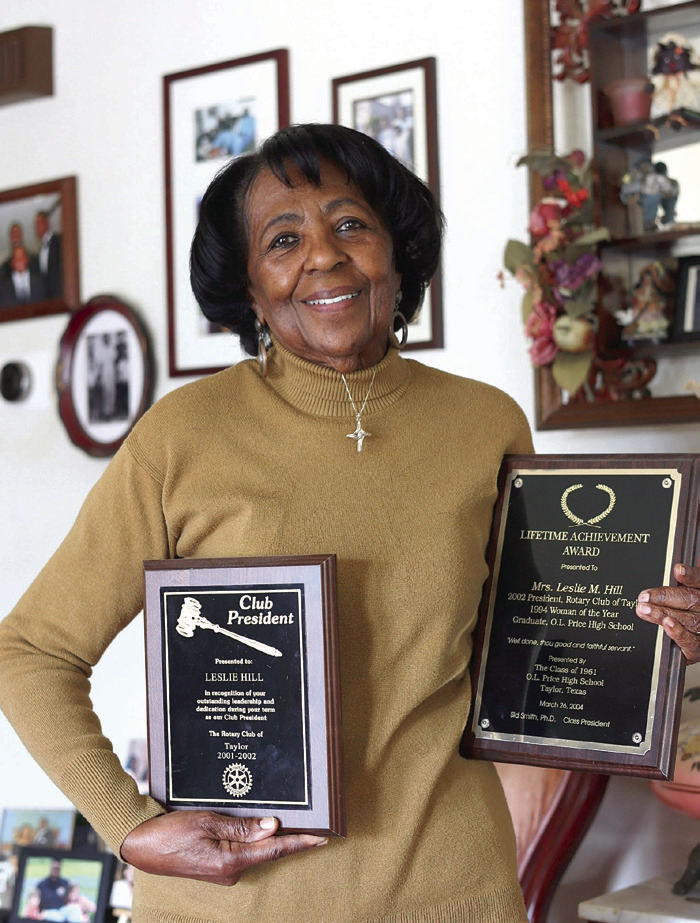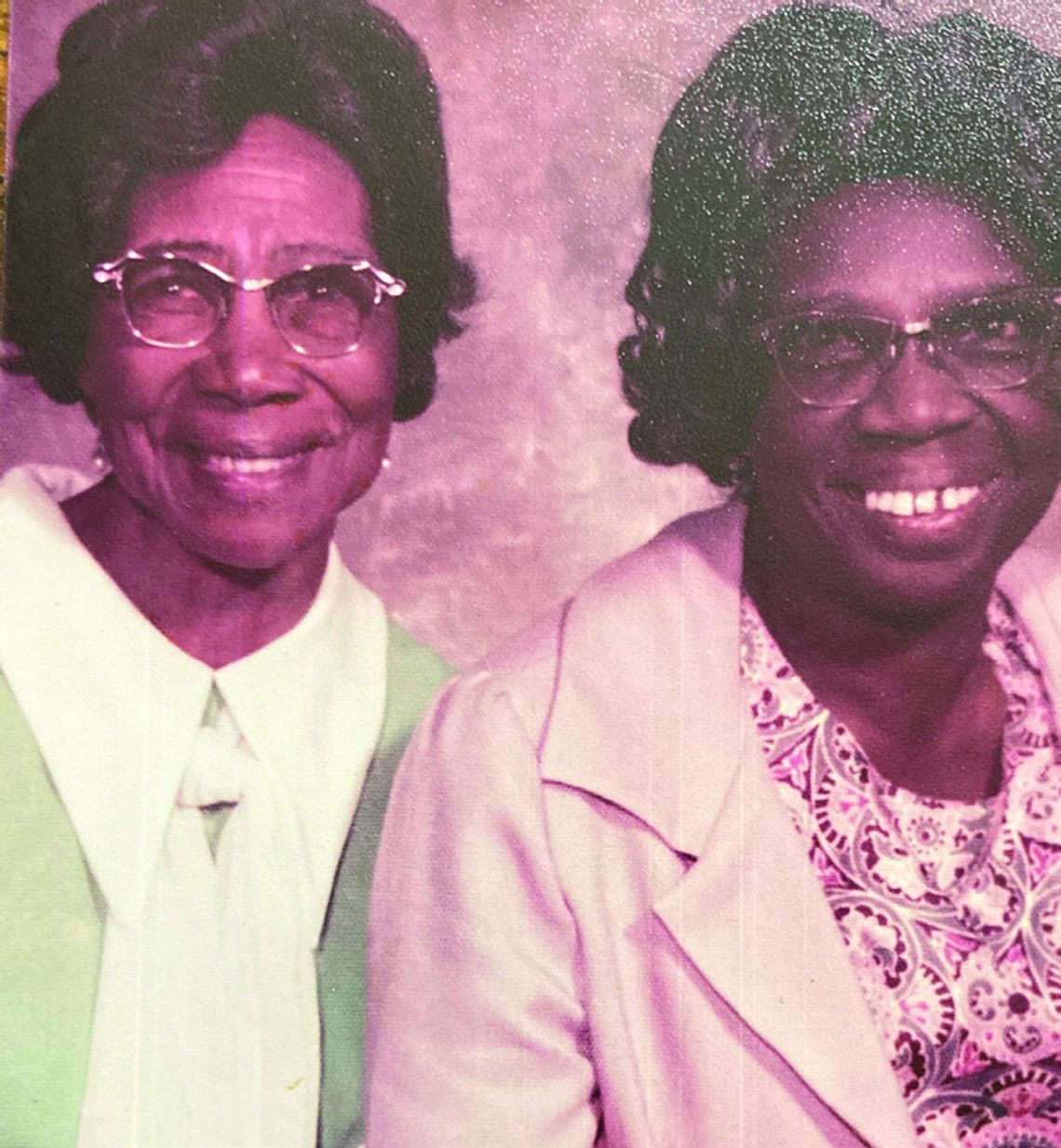FEBRUARY IS BLACK HISTORY MONTH
SCFHAOITOHL-, SBTURSEINNGTETGHR AND ATION Hattie Callins Moore: A profile of service and commitment
TAYLOR –– Whenever Laverne Caldwell recalls the late Hattie Moore, one word stands out to describe the perennial neighborhood mother and community leader largely credited with bringing school-bus service to Taylor after integration.
“Dedicated,” said Caldwell, 74. “She was definitely dedicated to everything concerning the Lord. … She was a pillar in the community, and not just in the Black community –– the community.”
Hattie Callins Moore was born May 17, 1917, in Bastrop County, the seventh child of a family of 10, to Matthew Callins and Pearl Hicks Callins. Early in Moore’s life, the family moved to Thrall and then to Taylor, where Moore attended the African American-only Blackshear Elementary and High schools through the 1920s and ’30s, which was an era of racial discrimination and segregation.
As she developed into adulthood, Moore touched many lives, from ministering to prisoners to helping found a credit union. But it is her work to close a racial divide in Taylor she may be best remembered for.
Over time, Taylor’s inhabitants of all ethnicities began to develop widespread respect for Moore, and she was able to harness that support to bring needed change to the area after integration.
BUS SERVICE FOR ALL STUDENTS
In 1969, she heeded the call to serve as the president and spokeswoman of the Taylor Neighborhood Association, which was hastily formed to demand school-bus service for students who lived within city limits but more than 2 miles away from their new places of learning after African American schools in south Taylor were suddenly and unexpectedly shuttered.
“A lot of the churches got involved in figuring out how to get these kids to school,” said former Taylor Mayor Don Hill, who is related to Moore through marriage. “All of us with the southern part of Taylor came together, African American, Mexican-American… and the community picked her (Moore) as the spokesperson.”
At the time, many young students had to navigate hazards to get to their new schools, Hill said.
“They had to cross railroad tracks and major highways, and we are talking about first and second graders,” he said.
Caldwell said she had to traverse two sets of railroad tracks to get to Taylor High School, which she graduated from in 1969, from her home on the east side.
“A lot of times we were late for school,” Caldwell said. “And the administrators were not always very cordial about it.”
Nonetheless, Caldwell said it wasn’t surprising Moore and other community leaders were able to not only convince the Taylor Independent School District board to approve funds to provide buses and maintenance to the community, but also raise the money to pay for a driver among the parents in south Taylor.
“She could get the ear of uptown Taylor, whomever was needed in the city,” Caldwell said. “Those men and women who fought for that, they could get the ear to benefit the kids.”
DREAM BIG
Despite this, great-niece Leslie Hill, 81, remembers her Aunt Hattie, who died in 2006, as a strict but selfless leader who tirelessly encouraged her and other African American youth growing up in Taylor to think big.
“She always wanted us to grow up to be part of this community,” Hill recalled of Moore, whose brother-in-law, Caldwell Washington, was lynched by a mob near Rice’s Crossing in 1933. “She said, ‘I didn’t have the opportunity, but you do.’” Hill recalled Moore, a low-income widow and mother of two with only a 10-grade education –– which was as far as her school went at the time –– as possessing great authority and respect among everyone who knew her.
“She was a Christian No. 1, and in my opinion, a true Christian,” Hill said. “She did ironing to make extra money for the family, and she cleaned houses. But when it came Sunday, you didn’t bother her. If it was Wednesday night, she wasn’t going to go anywhere but to prayer services.”
Through Mt. Calvary Missionary Baptist Church, Moore took on many leadership roles, including teaching Sunday school to neighborhood kids and serving as a deaconess. Regionally, she also volunteered for enrichment programs for Austin youth through the St. John Regular Missionary Baptist District Association, friends and family members said.
MOTHER FIGURE
Laverne Caldwell’s husband, Larry Caldwell, 74, said Moore was a motherfigure for him as well while he was growing up at Mt. Calvary.
“She was very influential,” said Caldwell, the pastor of Mt. Zion Baptist Church in Thorndale. “She was not afraid to say what was on her mind.”
But Moore was also encouraging, Laverne Caldwell added, recalling a specific Bible verse as a child she often

The most radical and racist person in town had the most respect for her. … She was one in a million.”
— DON HILL
FORMER TAYLOR MAYOR heard Moore repeat.
“‘I can do all things through Christ who strengthens me’ was a very popular Scripture when I was growing up,” Caldwell said.
As a disciple of Christ, Moore used whatever information or training she had to give back to the community, friends and family members said.
“(Moore) was very knowledgeable,” Caldwell added. “She couldn’t have done the things that she did otherwise. I don’t know about her education and accolades and stuff like that, but I just know people benefited from her work. She pushed education, that ‘You can be all that you want to be.’” In addition, people of all backgrounds benefitted from Moore’s ministries, which included praying every week with area prisoners, said Don Hill, 87, the husband of Leslie Hill.
“She would go to the jail every Sunday morning and pray for the inmates before she would go to Sunday School,” recalled Hill, who shares a family link to Moore by marriage on his mother’s side. “They recognized her and respected her. The most radical and racist person in town had the most respect for her… She was one in a million.”
Moore’s impact on the community was not limited to procuring school-bus service.
OUTREACHANDLEGACY
In 1970, Hill hired Moore as an outreach worker for Taylor Neighborhood Center, which was funded through the Office of Economic Opportunity as an offshoot of President Lyndon B. Johnson’s War on Poverty program. They helped lowincome residents access classes to earn a GED diploma, nutrition programs, naturalgas service and more.
“We would go out and find problems and help them get Social Security help and get them Medicaid,” Hill said. “(Moore) would go out and find problems, and if we couldn’t solve it right then, she would do it out of her pocket.”
Eventually, Moore would become the TNC’s director before going on to help form a credit union with Hill, community leaders and Americorps Vista volunteers, to fight the predatory lending practices that many African Americans at the time faced.
“She was one of the founders of the credit union that eventually became University Federal Credit Union,” Hill said. “She was the board president of that for about 20 years.”
Though Hill, who is also Taylor’s first Black mayor, was Moore’s boss, he said she would not hesitate to correct him in a staff meeting, or even grab him by the ear, if he said the wrong thing.
“I was her boss in a way, but also I was her nephew, you know,” Hill said with a chuckle. “Her brother and my aunt ... divorced when I was a little, bitty fellow. But my mother and her were sisters-in-law. She was a beautiful person who would give her last stuff up for another.”
Though Laverne Caldwell also served with Moore at church, as well as professionally as an outreach worker and while working at the credit union, she will always see her as one of the strong mother figures from the community who guided and shaped her life.
“There were many obstacles that we had to deal with,” Caldwell said. “And it was just because we had people like Miss Moore, and people of her generation, who were willing and able to fight for what was needed.”
She was very influential.”
—LARRY CALDWELL
MT. ZION BAPTIST CHURCH









Comment
Comments